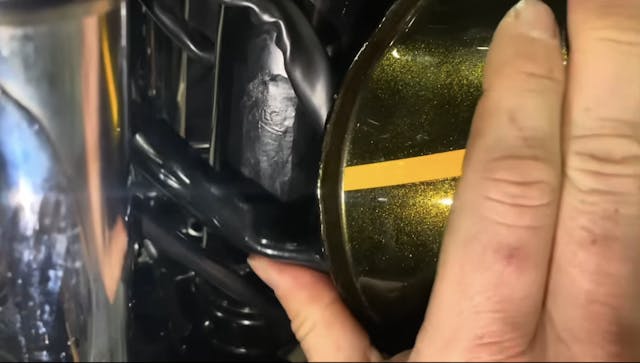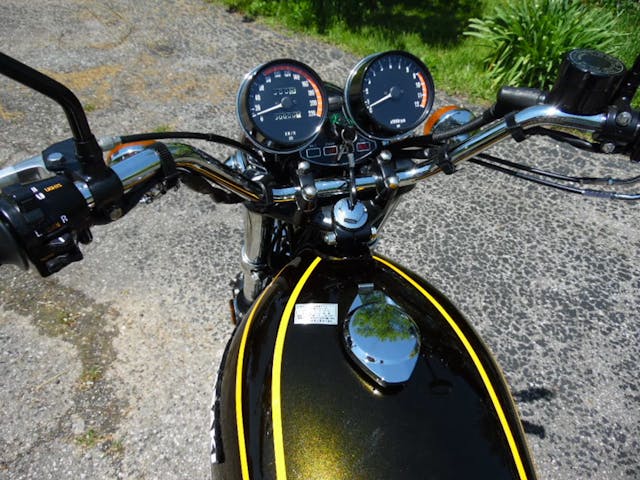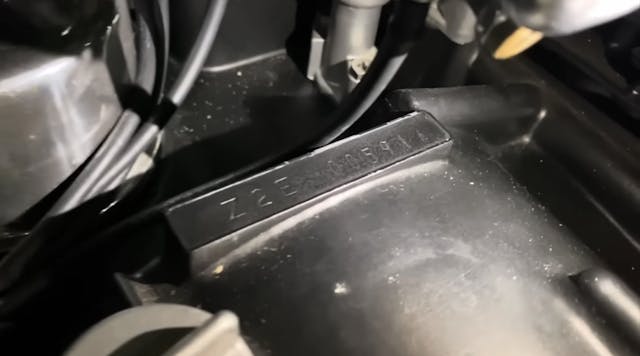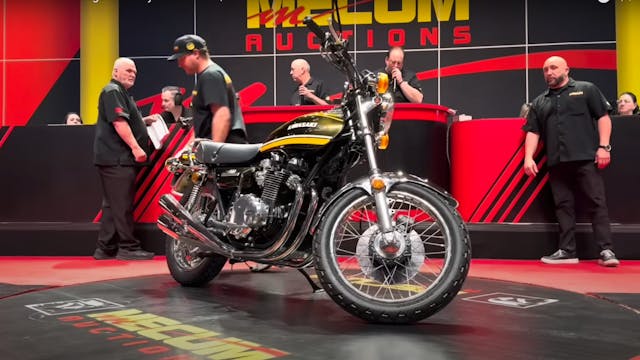Questions Raised, and Answered, About Kawasaki Sold at Mecum Auction
Immediately following its blockbuster Kissimmee, Florida event (now the largest collector car auction in the world), Mecum Auctions held its 33rd Annual Vintage and Antique Motorcycle Auction at the South Point Hotel and Casino in Las Vegas.
This has become the largest motorcycle auction in the world, with the 2024 event featuring some 2000 motorcycles.
One of them, a 1974 Kawasaki Z2 750RS, was among the auction’s modern-era stars, with a Mecum-estimated price of $75,000 to $95,000. That estimate was spot on, with the Kawasaki selling for a gavel price of $85,000.
Though Mecum is scrupulous about vetting the vehicles it sells, shortly after the Kawasaki was sold, questions were raised about the motorcycle’s authenticity.
But first, why did this bike sell for so much? Because the Z2 was a Japanese-only motorcycle, sort of the little brother for the 900cc Z1 widely sold in America beginning in 1972. Japanese law prohibited bikes with larger than 750cc engines, so Kawasaki built the Z2 for its domestic customers. It went on the market in March of 1973.
According to a 2017 story in Motorcycle Classics magazine, many American military servicemen stationed in Japan during the 1970s bought motorcycles there for fun and for transportation, and some brought their bikes home after their tour of duty ended. A Kawasaki collector quoted in the story suggested that as many as 25 to 50 of the 69-horsepower Kawasaki Z2s made it back to the States. Fewer than that have survived, making the Mecum-sold Z2 a legitimate collector’s item.
But the same day the Z2 sold, questions arose. The story broke with a YouTube video posted by CycleDrag.com, titled “Inauthentic Vintage Motorcycle Sold for $85k at Auction?” The description said, “Following the auction it was discovered that the VIN was ground down and was not legible, something that would drastically impact the value of the motorcycle and its proof of authenticity.”

The video showed the Vehicle Identification Number, or at least where the VIN ought to be, on the left side of the headstock of the Kawasaki. It showed a bumpy black surface, with the only part of the VIN legible being the number 75, which looked as though it might have been struck recently. Mecum listed the full VIN, and the last two numbers were indeed 75. The video’s host, CycleDrag’s Jack Korpela, said the Z2 was “one of the most acclaimed bikes here at Mecum, and now there are some serious questions about it.”
According to YouTube, the CycleDrag channel has 580,000 subscribers. It wasn’t so much the video, which is reasonably balanced, but the 500-plus comments posted about the video that are, by and large, profoundly critical of both Mecum and the seller, identified in a CycleDrag.com story and photos as Marcus Swan.

Said one comment: “This is on Mecum. For the fees they charge, they should be on the hook. They should be validating everything. This isn’t eBay.”
Another: “I can’t believe Mecum didn’t verify the frame/number before the sale.”
Still another: “This is not some backyard auction, how could someone show up with that bike and not think the grinding of the numbers wouldn’t be noticed?”
The same day of the sale, Mecum refunded the $85,000 to the buyer, and shipped the Z2, at Mecum’s expense, back to the seller, who had left the auction following the sale.
We reached out to Director of Mecum Motorcycles Greg Arnold for comment, and it was enlightening. “Unfortunately,” he said, “we’re not happy having the story out there that we sold a motorcycle with the VIN ground off. It’s just not true.”
The explanation: “The frame had been powder-coated and that had obscured the frame VIN,” Arnold told Hagerty Insider. “So we asked the seller, before the auction, to remove the powder coating either by grinding or sanding to expose the frame number. He did that at our request and sent us a photograph of it. It’s not great, because of the process he had to go through to get the powder coat off. But there is a frame VIN. So we looked at it and decided that it was passable, and we ran it in the auction.

“We have the photograph of the bare-metal frame VIN, and it corresponds to what the title was. After he did that, he spray-painted over it again, so it wasn’t bare metal. The pictures we see on YouTube, he just painted over the numbers again. Which is certainly understandable.
“Now, after the sale, the buyer had a representative there, someone who I know from past dealings, and he had been alerted by CycleDrag, though certainly he would have questioned it himself. He said, ‘I’m not sure I like this.’ And we said, ‘You know, we’re not going to make anybody take this bike, on this basis, so you talk to your boss and if he doesn’t like it, we’ll be happy to unwind the deal. We’ll send it back to the seller.’
“That’s the long and the short of it. The report that the serial number was ground off is not accurate,” Arnold said. “I think the seller was acting in good faith.”

The YouTube video also questions whether or not the engine VIN should have a small ridge in front of it, which the 1974 Z2 in question does, suggesting that the ridge first appeared on 1975 models. “I have a guy who is very deep into Kawasaki history,” added Arnold, “and he said, ‘No, that ridge is OK.'”
“Here’s the thing,” Arnold said. “It’s a 50-year-old bike. As we all know, there were running changes constantly. It would be hard for me to say this motorcycle is inauthentic. I’m not a 1974 Kawasaki expert, I freely admit that. But if the owner can raise the VIN on the frame, I think he’s got a legitimate motorcycle,” which is what the seller says he’ll do in the CycleDrag.com story.
The bike, Arnold said, should be a “featured piece in someone’s collection.”
***
Check out the Hagerty Media homepage so you don’t miss a single story, or better yet, bookmark it. To get our best stories delivered right to your inbox, subscribe to our newsletters.



Well NOW it will go for 100K wirh the lurid backstory… Korpela threw furl on the fire when he referenced to seller having “left the auction right away after the sale” (slightly paraphrasing)
It still seems like a lot of work went into concealing the frame VIN. We all know that when we repaint/rebuild a bike, that the VIN plates are taped off so that there isn’t any obscure marks on said plate.
If you are pulled over and an Officer looks at a VIN plate of any location on the bike and it has any discerning or peculiar marks on it, that the bike is typically impounded until verified by said Officer or department.
No one “grinds” powder coat and then paints back over te very object you are trying to reveal. If you are worried about rust, then you will use clear coat, not more black paint.
I’ve been in and around motorcycles and automobiles and equipment long enough to know that there are all sorts of shenanigans to be had, especially when there is “rarity” and lots of money to exchange hands.
If this truly is the bike that the owner/seller says it is, then the rebuild process would have been documented, because it would more than likely have been performed by a professional, not someone in a wooden shack doing a Hack job. But I it was a hack job, the. It wouldn’t be worth 1/100th the value they think it is.
It is a good thing this bike was returned to the seller. If he has the appropriate paperwork and validation of a rebuild/restoration, then e can submit it for everyone to see.
If they don’t produce any appropriate materials, then we all know it is a fraud. If it is proven to be a fraud, then all involved need to be prosecuted and placed in prison and that bile destroyed, in a public setting and broadcast for all to see.
“We all know that when we repaint/rebuild a bike, that the VIN plates are taped off so that there isn’t any obscure marks on said plate.”
Right. Very fishy story on the part of the seller.
Except taping it off for powder coating won’t work. And it would leave the area susceptible to rust
Couldn’t have said it better myself.
I wouldn’t want to see the bike destroyed, just resold as what it is – a clone or tribute bike or an homage to the real thing.
Only to a fool. Read my comment below and you’ll understand why I say that.
Say it isn’t so 🤦 Frankie.
So those idiots at cycle drag caused this bs commotion ? Then this cycle drag idiot should be held responsible.
I have a friend that has a Kawasaki Z2 in his bike collection. Sitting their dust covered rotting away here in Indiana. What a shame. He acquired it from a service man that came back state side from over seas years and years ago.
I once looked at a Corvair Yenko Stinger that Mecum had going up for auction. After digging into the vehicle’s claimed history, it was fraud… more-so a recreation. After documenting this to Mecum they gave me all kinds round-about excuses of why I was wrong. Obviously I did not buy it and Mecum continued to list it, and eventually auctioned it to a buyer that fell hook line and sinker for Mecum’s claim that the Stinger was original!
Hey Tom. How are you?
Well show the picture of the bare metal with the serial number ?????
Title says: ‘Questions Raised, and Answered’
There are NO answers!
I’d think Mecum or any major auction house has done their homework as best they can to ensure a vehicle is what it’s supposed to be. I wish the seller would know not to cover up the VIN on any vehicle they’re trying to sell. Also, what info was told to the buyer, prior to the sale?
But, the bigger issue is in this age of social media, getting views and likes is very important…. regardless how it happens. A big tag line is Mecum screws someone out of 85k. And possibly no real research being done by the poster…..with no repercussions for irresponsible info.
I watched the video of the Z2 at auction, and paused it to study the close-up of the grind job on the VIN number. I could not believe that anybody would try to either sell, auction, or purchase a vehicle with such a blatant flaw.
Must’ve used a 4 inch side grinder with a course wheel to get that powder paint off? Also, looks like a thick brush job cover up. I’m sorry, but this vin has been ground off. If the owners story is true, then he needs to get the guy that did the hack job of grinding. Light sanding would have exposed the vin perfectly fine. Who would use a grinder? Someone covering up a different vin or getting rid of one.
Another reason people should know about the non-abrasive method of removing paint or coatings, including powder coatings. Dry Ice blasting with the correct machine and expertise can remove all finishes without damaging the substrate. No other method can prevent the loss of metal or substrate finish.
Well folks let’s just back things up from the Vegas auction 1.this bike would have been scrutinized coming into America upon importation from Japan by customs2.the bike would have to be certified in the US by a mechanic to exchange the ownership to a State Title 3.In the restoration pictures of just the frame you can see the white manufacturers tag on the head (missing in videos later) 4.the bike was one of of the key rides going into the Vegas auction,pictures of the frame and engine are required with the Title months prior to arrival in Vegas.5.the steering head and engine numbers are to be checked physically by Mecum officials on day of arrival.6.the bike had some of the best builders from all over the world not just Americans of those desirable years that know the bikes like the hairs on their children’s heads but the representative hovered around the bike steady and had the bars turned to the head side thet houses the serial number. I’ve been to car bike and boat auctions all over the world and have seen some very unusual vin number changes and are usually detected by potential buyers when the item is on floor display leading to crickets when it hits the block.Buyer beware always ,but to bring this to an auction in todays world is plain crazy,it should have been caught well before podium time.If it’s a real matching correct frame it can be torn down again and professionally checked as several labs can do with altered serial numbers on firearms.This bike being as valuable as rare and of only a few in the US been stated several times then get it done /spend the money and clear the air as this issue is being debated on every level of auction houses world wide.Possibly should have been enjoyed in the owners town and not displayed for the world to see…..
If indeed the VIN was painted over, but a photograph of it before painting was made to alleviate any concerns about authenticity, then why would the picture of the original VIN not be part of the package for the bike when it was auctioned. This whole story still has a bad smell to it.
What if the picture is of a bent-up useless frame, and the frame on the bike is a different one?
Not saying it is that. Just asking for a friend.